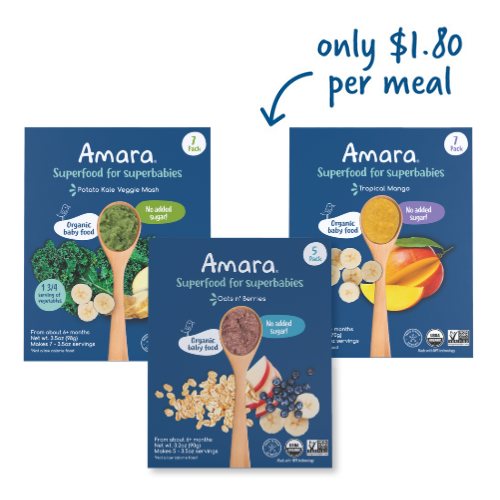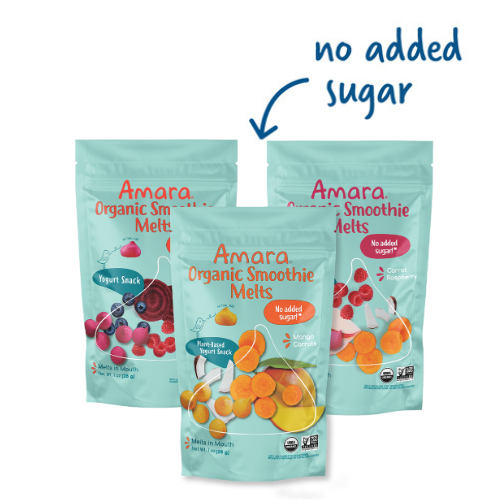
The Secret to Getting Your Kids to Like a New Food
We talk a lot about taste preferences here at Amara, and that’s because we really care about what your child likes and wants to eat.
You see, we start forming taste preferences very early in life — in utero, in fact — and infancy and early childhood are such critical time periods for building healthy taste preferences and eating habits…for life. We discuss taste preferences so frequently because their development is central to our mission and what we are all about, which is: bringing delicious, nutritious, accessible food to your family table, starting from the first bite.
The Development of Taste Preferences (aka “why do we like the foods we like?”)
To a certain extent, we have some ability to influence what and how our children like to eat (we’ll get to that shortly…), but taste preferences are no simple phenomenon. They don’t follow any reliable logic or move in one direction. Instead, taste preferences are a highly complex function. They’re influenced by genetics, evolution, individual personality, gender, age, and various cultural and environmental factors.There’s a lot that goes into it. Not to mention, flavor preferences aren’t set in stone — not at all. From their first inklings of development, they continue to shift throughout the entire life cycle. How many of us love foods that we detested as children? Or dislike some of our favorite childhood dishes? I know I do.
Yes, taste preferences are highly complicated and highly individual. They run on a continuum and are constantly in flux.
That said, there are some innate human taste preferences we can point to, and there are also critical periods of development — time periods where the body seems to be hyper-sensitive to forming its own preferences. Let’s take a look:
Innate Tastes: From an evolutionary standpoint, humans generally prefer sweet foods because they tend to be energy-dense. In the far, far past, when food was scarce and took quite a lot of time and energy to obtain, this preference would have been advantageous. In today’s modern industrial societies, though, food is abundant, ubiquitous, (mostly) easy to obtain, and (often) highly processed. The innate preference for sweeter, high-energy foods no longer serves us, but it remains nonetheless.

The First Two Years:Researchers have honed in on a key window of time in the development of flavor and taste preferences, and it is the first roughly two years of a child’s life. There’s a lot that’s happening during this period that contributes to making it so critical in the world of culinary matters: babies actually start eating foods, their brains are growing like crazy, they’re programmed to explore the world with their senses (their way of “checking something out” is to put it in their mouths…), they’re learning about eating from their parents, their sense of smell is maturing, and they’re generally just more open to trying new things at this stage. It’s a win-win-win-win.
Technically, a baby’s taste buds are activated in the womb (around week 30 of pregnancy), and from there on out a fetus can actually detect flavors through amniotic fluid. In scientist speak, this is the beginning of a baby’s “gustatory sensory memory” (throw that one out at your next dinner party…) — it’s the onset of a lifelong learning project encompassing the full sensory experience of tasting and eating different foods. How exciting!
Before they’re even born, then, every baby has (sort of) already tasted foods their mother eats, and has some familiarity with basic flavor profiles: sweet, sour, salty, spicy, etc. These early exposures, besides being cool, can also begin to help shape their likes and dislikes later on in life. After birth, babies who are breastfed continue to have exposure to various tastes and flavors through what their mothers eat, because the maternal diet influences the composition, flavor, and smells of breast milk. In an ideal world, a breastfeeding mother who ate a very balanced, diverse diet would help introduce her growing baby to all kinds of different tastes, stimulate the baby’s curiosity for different foods, and accustom him to a diet of healthy foods.
In fact, young children who were breastfed as babies do tend to eat more fruits and veggies — enough such that scientists speculate that breastfeeding plays an important role in “promoting” (hah!) healthy foods. The theory is that breastfed babies have additional, repeated exposures to all kinds of flavors and tastes (through breastmilk) that formula fed babies technically miss out on. That said, if you’re formula feeding (or did 🙋🏻♀️), don’t worry. Seriously. Some of the most adventurous little eaters I know were brought up on powder, and there are plenty of cultures where breastfeeding is far less common than in the U.S. — ahem, France — that are known for raising mini gourmands.
What do these places do “right”?
Repeated exposure.
Say it with me:repeated exposure.
Okay, friends — what is repeated exposure?

Repeated Exposure & Food Acceptance
There’s no strict definition, and at the most fundamental level, repeated exposure in the dietary world is pretty much just what it sounds like: ongoing and continual access/experience to a food.*And science shows us that the more we are exposed to any given food, taste, flavor, or texture, the more likely we are to eat it, like it, and enjoy it in the future.
This phenomenon is true across the board in terms of age,but it’s especially prominent during that critical window of development in the first two years.IOW, infancy and toddlerhood are the sweet spots for reaping the benefits of this phenomenon^^.
Numerous studies show that babies who are served foods over and over again are more likely to actually eat those foods and more likely to like the flavor of those foods.
Okay — so, to a certain extent…duh, right?
But it’s actually an incredible — and tricky — finding. Nutrition studies are notoriously difficult to run, and it’s no different here. The research isn’t perfect, but it’s telling:
When scientists set out to assess the effects of repeated exposure among young children, they design studies that look at the before and after. They choose a food (often, it’s a bitter vegetable that children don’t innately enjoy, such as green beans or broccoli), measure children’s baseline consumption of said food, ask parents to implement a schedule for repeated exposure (2x/week for 3 months, say), and then look at the outcomes. How much of the food does every child eat after the intervention? Is it more or less? What faces do they make when they eat it? What do the numbers look like among children who received no such intervention?
Now — these studies have the standard suite of nutrition science caveats (every baby is different; most of the results are self-reported by parents and could be subject to error or bias; preferences can change naturally with age; we don’t know if the results translate from one food to another; etc.), but at this point scientists are in agreement: there is extensive evidence showing that repeated exposure has the potential to cultivate a child’s taste for vegetables and increase a child’s overall vegetable intake. (And this is a GOOD thing because the vast majority of Americans are not consuming enough vegetables.)
To be clear,this is no guarantee. Just because studies show that repeatedly serving a child broccolican “train” that child to enjoy and consume broccoli does not mean that it necessarilywill all the time — or that it will also “work” for other foods. Furthermore, the nomenclature can be a bit misleading: technically a mere “exposure” to a food (as in, just seeing or smelling it), doesn’t quite cut it. A child has to actually TASTE the food in order for the exposure to “count,” in the strictest sense. (*PSA: this doesn’t mean you should ever force your child to eat/taste anything — this will only backfire. See here for some helpful tips on overcoming picky eating.)
In the end,the more familiar the flavor and food is, the more likely a child will be to taste that food… and eventually grow to like it.
Repeated Exposure: DIY
So — how do you actually go about using this information? What does “doing” repeated exposure look like? Here are some tips, tricks, and things to know if you “try this at home”:
- Don’t stop serving healthy foods.
The biggest piece of advice is also the simplest: stick with it. Research shows that most parents “give up” with a new food after about five exposures. But that’s not enough! Current recommendations suggest aminimum of 8-10 exposures and some dieticians even say that it could take dozens of exposures for a child to accept a food. You’ve got to just keep going…
Also:
Babies automatically make certain faces in response to certain flavors — most notably, a “yuck” face when they taste bitter foods and veggies. Don’t rely on this as a sign your baby dislikes a food. It’s an instinct, not a reliable indicator of taste!
Older toddlers and pre-K-aged children arepredisposed to reject new foods — don’t hold it against them! Neophobia, or an extreme/irrational fear of novel foods and flavors, peaks between the ages of 2 and 5. If you are in the throes of this,work with it, not against it. Keep putting things on your kid’s plate (and see here for some helpful serving ideas), and don’t lose heart.
Remember that in some ways — and it’s brutally ironic, seriously it kills me — we’re working against biology. Our kids are literally hard-wired to prefer things that aren’t that great for them (energy-dense, sweet foods) and be averse to things that are great for them (cough, vegetables) but may have posed a safety risk in the long past.
Keep in mind that even if you’re serving broccoli [or whatever] every day doesn’t result in your baby or toddlerloving broccoli, the mere fact that you are helping your child grow accustomed to seeing new things on their plate — or being okay with things they don’t really want to eat on their plate — and not freaking out is a WIN. (Trust me. 🙄)
Yes, repeated exposure helps cultivate a child’s overall curiosity about food, willingness to experience new foods, and keep an open mind — and these simple things can truly carry you pretty far, even if it doesn’t result in your child chowing down on carrots/leeks/peas/spinach… <<This is my parental explanation — but there’s research to back it up. As experts would explain it, repeated exposure to foods helps children build “learned safety,” meaning it teaches them that having [eggplant] on their plate, or tasting [eggplant] — even if they don’t expect to like it — is SAFE.
Children pick up on their parents’ attitudes about eating, meals, foods, and dietary norms. It’s hard (SO hard sometimes…), but try to leave your stress elsewhere whenever you are feeding or eating with your child.

As mentioned, forcing your baby or toddler to taste something is more likely to build a negative association with that food than it will encourage them to like it.
Researchers call this technique “flavor-flavor learning,” and it can work in two ways:
- If you’re working on growing some love for cauliflower, and you know your child loves sweet potatoes, serve them together. Rather than putting out cauliflower alone on a plate, or served alongside something your child isn’t familiar with, this strategy can help kids feel more comfortable with new foods.
- Alternatively, you could serve cauliflower with a dip your child likes (hummus, nut butter, etc.).
You don’t have to serve a food exactly the same every time — and in fact, it’s great to mix things up! Consider changing up how you cut, prepare, or serve any food to incorporate variety. Maybe your child doesn’t like steamed carrots, but they love roasted carrots. Maybe they aren’t into avocado, but you roll it up in some panko breadcrumbs and that’s a hit — don’t be afraid to experiment.
We tend to focus on foods and flavors when we discuss repeated exposure, but the same basic concept also applies to textures. The more comfortable your child is trying foods that are crunchy, soft, gelatinous, chunky, smooth, etc., the more comfortable they’ll be trying other foods with those same textures later on. (I missed the boat on this one and my son is now repulsed by any and all foods he deems “slimy.” We’re still trying…)
Your kid may never like broccoli, and that’s okay! We all have certain foods we don’t like — including healthy foods — andwe’re fine. It’s fine. Don’t waste your precious time or energy fretting if your child doesn’t like peas (or anything else). Instead, keep circling back to it periodically, and pick something else fun to put at the center of your menu in the meantime.
Even in the top studies exploring repeated exposure, the interventions are very doable (once or twice per week!). You can replicate that. Shoot, I could replicate that. Repeated exposure doesn’t have to be complicated, and it doesn’t have to be that involved.
You don’t need to have a big chart on your wall if you don’t want to, or count exposures. If it suits you, you could make a plan (or pretend to be a scientist, lol), but you don’t have to. And even this need not be overly complex: just pick a food and decide on a number of times per week and a duration to offer it, and see what happens. Watch and observe. (And let us know how it goes!)
Lastly:
Some foods and flavors are harder/easier to prep than others. Don’t feel like you have to bend over backwards to serve the toughest ones (ahem, daikon radish…).

At Amara, it’s our mission to set up every child for a lifetime of healthy eating, starting right from their first bites. We know how important the first years are in establishing children’s eating habits and taste preferences, and we also know how much time and energy it can take to put healthy, flavorful, nutritious food on the table. That’s why we make 100% real baby foods and toddler snacks in a variety of fresh flavors, ranging from savory to sweet and exotic to staples.
Our foods use a nutrient-pressed technology that locks in all the good stuff (nutrients, tastes, textures) to make whole foods convenient and accessible for every family. Our ingredients are certified organic, picked at peak harvest (when they are most nutrient dense and flavorful), and 100% plant-based, too! Check out our full line of organic baby foods and toddler snacks for an array of fresh-tasting flavors and fun pairings for your baby or toddler.
References:
SJ Caton et al., Learning to Eat Vegetables in Early Life: The Role of Timing, Age and Individual Eating Traits. PLOS ONE 2014
V De Cosmi et al., Early Taste Experiences and Later Food Choices. Nutrients 2017
CA Forestell & JA Mennella, Early determinants of fruit and vegetable acceptance. Pediatrics 2007
M Hetherington & C Schwarz, A Step-by-Step Introduction to Vegetables at the Beginning of Complementary Feeding. The Effects of Early and Repeated Exposure. Appetite 84(1), 2014
S Issanchou Sensitive Periods And Factors In The Early Formation Of Food Preferences. Ebook.ecog-obesity.eu 2015
A Maier et al., Effects of repeated exposure on acceptance of initiallydisliked vegetables in 7-month old infants. Science Direct, Food Quality and Preference 18 (2007)
L Paglia, Taste development and prenatal Prevention. European Journal of Paediatric Dentistry, 2019
A Pietrobelli et al., Nutrition in the First 1000 Days: Ten Practices to Minimize Obesity Emerging from Published Science. Int J Environ Res Public Health 2017
MK Spill et al., Repeated exposure to food and food acceptability in infants and toddlers: a systematic review. Am J Clin Nutr 2019
AK Ventura, Does Breastfeeding Shape Food Preferences? Ann Nutr Metab 2017









Thanks for publishing a nice blog on “When i.e. in what age of babies what healthy food should be given to them.” It is a very helpful blog to the mums. You gave importance to brand healthy Amara Food items which is a very popular brand. I think moms should follow your process.
– Organic Products Australia November 07, 2023